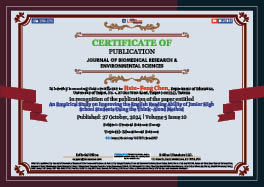Hsiu-Feng Chen*
Volume5-Issue10
Dates: Received: 2024-10-18 | Accepted: 2024-10-25 | Published: 2024-10-27
Pages: 1388-1397
Abstract
The aim of this study is to investigate the impact of the Think-Aloud Method on junior high school students' English reading proficiency and to empirically verify the effectiveness of this strategy in English learning. The Think-Aloud strategy encourages students to verbally articulate their internal thought processes during reading. This approach assists students in understanding the text and identifying difficulties they encounter while reading. The research focuses on eighth-grade students from a junior high school in New Taipei City. After an 18-week teaching and observation period, a case study was conducted using qualitative analysis to examine changes in students' English reading ability through pre- and post-tests.
The findings reveal that the Think-Aloud Method significantly enhances students' reading comprehension, helping them pinpoint reading challenges and facilitating the development of their learning strategies. Additionally, the students demonstrated increased motivation toward English reading and greater confidence in tackling reading challenges. The study also discovered that integrating the Think-Aloud Method with cooperative learning or pair-based exercises was particularly effective in improving students' learning outcomes.
Finally, based on the research findings, the study offers recommendations for implementing the Think-Aloud Method in English reading instruction and provides suggestions for future research, aiming to serve as a reference for educators and researchers alike.
FullText HTML
FullText PDF
DOI: 10.37871/jbres2027
Certificate of Publication

Copyright
© 2024 Hsiu-Feng C. Distributed under Creative Commons CC-BY 4.0
How to cite this article
Hsiu-Feng C. An Empirical Study on Improving the English Reading Ability of Junior High School Students Using the Think-Aloud Method. J Biomed Res Environ Sci. 2024 Oct 27; 5(10): 1388-1397. doi: 10.37871/jbres2027, Article ID: JBRES2027, Available at: https://www.jelsciences.com/articles/jbres2027.pdf
Subject area(s)
References
- Chen CJ. Reading class: 15 great articles from business weekly to read with your children. Business Weekly. 2014.
- Chou SH. The courage to let go: How to change the status quo, break free from limitations, and win more in life. Times Publishing. 2016.
- Gagne ED. The cognitive psychology of school learning. Boston, MA: Little Brown and Company; 1985.
- Yen CR. The application of the think-aloud method. Secondary Education. 2007;58(4):106-116.
- Liao PS. Translation research method: Think-aloud protocol (TAP). 2012.
- Fox S, Riconscente M. The think-aloud protocol in educational research: Insights into students’ cognitive processes. Journal of Educational Psychology. 2022.
- Ziegler J, Sternberg R. Problem solving and think-aloud protocols: Exploring the role of verbalization in cognitive performance. Journal of Cognitive Psychology. 2022.
- Bannert M, Sonnenberg C, Mengelkamp C, Pieger E. Think-aloud methodology in computer-based learning: Implications for research and practice. Educational Technology Research and Development. 2020.
- Van Someren MW, Barnard YF, Sandberg JAC. Advances in the think-aloud method: Cognitive processes in human-computer interaction. Human-Computer Interaction Journal. 2023.
- Alderson JC, Clapham C, Wall D. Assessing reading through think-aloud protocols: A cognitive approach. Language Testing. 2021.
- Cazden CB. Peekaboo as an instructional model: Discourse development at home and at school. Stanford: Department of Linguistics, Stanford University; 1979.
- Hogan K, Pressley M. Scaffolding student learning: Instructional approaches and issues. Cambridge, MA: Brookline Books; 1997.
- Palincsar AS, Brown AL. Reciprocal teaching of comprehension-fostering and comprehension-monitoring ctivities. Cognition and Instruction. 1984.
- Pea RD. The Social and technological dimensions of scaffolding and related theoretical concepts for learning, education, and human activity. Journal of the Learning Sciences. 2005.
- Hsieh CJ. The development, types, models, and implications of scaffolding theory in science education. Science Education Monthly. 2013.
- Van de Pol J, Volman M, Beishuizen J. Scaffolding in teacher-student interaction: A decade of research. Educational Psychology Review. 2010;22: 271–296 doi: 10.1007/s10648-010-9127-6.
- Zhang H, Lin Y. Exploring the role of scaffolding in creative problem solving. Journal of Educational Computing Research. 2021.
- Azevedo R, Taub M, Mudrick NV. Understanding and researching the role of scaffolding in self-regulated learning: Opportunities and challenges. Metacognition and Learning. 202.
- Hmelo-Silver CE, Barrows HS. Problem-based learning: An overview of its key characteristics and the role of scaffolding. Educational Psychology Review. 2021.
- Barrett AM, Crossley M, Dachi H. Using research to enhance learning and equity. International Journal of Educational Development. 2021.






























































